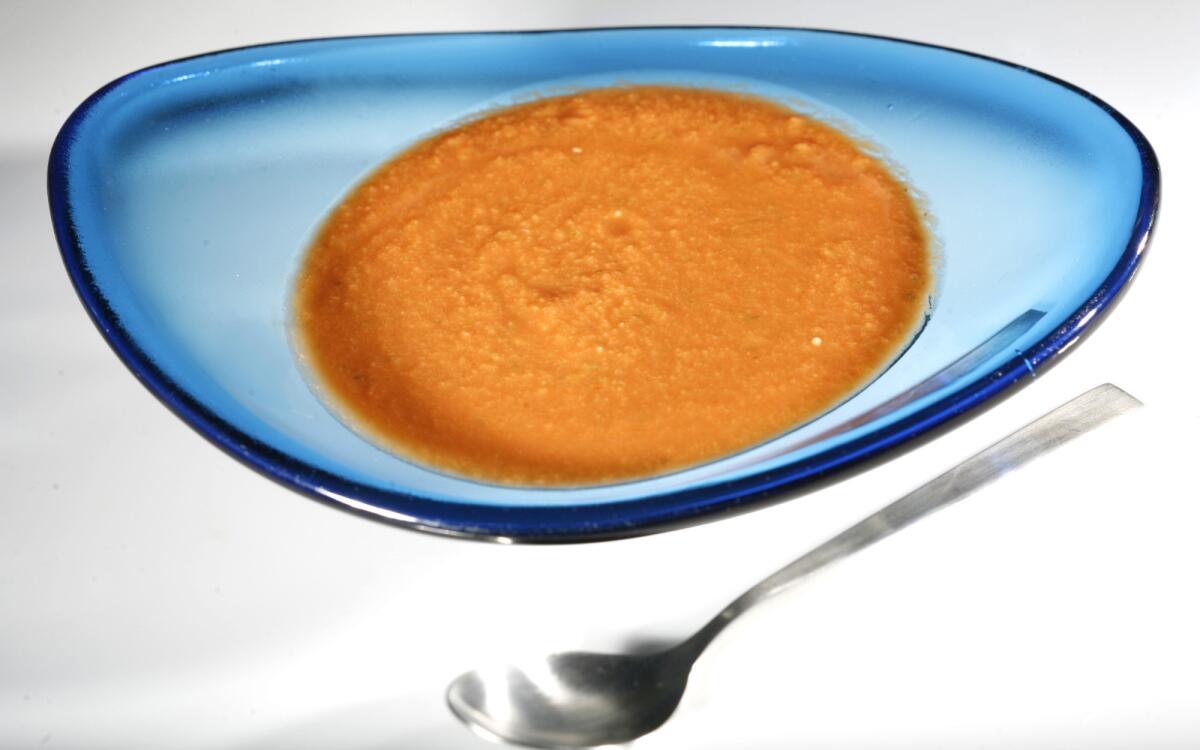Gazpacho

- Share via
One of the things that’s most important for a cook is to keep an open mind about food and constantly challenge the limitations of our perspectives and prejudices. That’s something I had to learn myself as a young chef. Even after I became serious about cooking, there were certain dishes that just didn’t excite my imagination. One of those was soup.
It was not until I dined at chef Alain Chapel’s eponymous restaurant in France that I finally realized how much a skilled chef could elevate such a humble dish. But I almost missed the chance. Blinded by my prejudices, I had decided to forgo a soup in favor of other dishes further down the menu. However, my captain -- a true skilled professional -- lobbied strenuously for the soup and finally convinced me that I really ought to give it a try.
Chapel’s mushroom cappuccino was deceptively simple: a mushroom consomme enriched with foie gras and topped with foam. Yet the intense consomme possessed a perfect balance highlighting each of the different wild mushroom flavors. The foie gras emulsion gave the soup a rich texture and silky mouth feel. Presenting the soup as a “cappuccino” gave the entire experience a whimsical flourish despite the underlying elegance of the dish.
It was one of his most memorable dishes I’ve had. In fact, it made such an impression that not long after, when I opened my restaurant Rakel in New York, I included my own interpretation on the menu.
Since then I have come back to soup time and time again (and that’s in both my cooking and acting career for those of you who are Pixar fans) -- always fascinated and challenged by the possibilities it offers.
Soup is an ideal way to begin a meal, and it will always have a place at my table regardless of the time of year. In summer, when we crave fresh flavors and light dishes, chilled soups offer us a perfect venue for showcasing an array of produce from the garden.
The soup recipes here demonstrate the variety of tools we use to extract these flavors in their purest form. Some (gazpacho and vichyssoise) are practically meals unto themselves, while others (corn soup and carrot consomme) are meant more as a palate-awakening amuse bouche.
Some are quite simple to make. For the gazpacho, you just chill the ingredients overnight to marry the flavors and then puree (straining afterward will give you a more elegant result).
Cucumber vichyssoise is only a little more complicated. For this recipe, a juicer really helps, though if you don’t have one you can simply blend the cucumbers and then strain them.
Other soups are more involved but repay the effort. For corn soup, you cook some corn kernels sous- vide and juice the rest. Then you make a corn stock from the cobs. Finally, you bring them all together with reduced cream to create a silky texture and intense flavor.
For the carrot consomme, cold-clarify juiced carrots -- thicken it with gelatin to suspend the solids, then freeze it and slowly defrost it in a strainer in the refrigerator over several days. The result is almost crystal clear but incredibly fragrant.
Although they vary in the amount of time and effort they take, all of these recipes aspire to that highest calling of a soup: to perfectly express its primary ingredient. The techniques are diverse, but the end result should always be a powerful flavor experience with an intensity that I hope would please even chef Chapel.
In a large bowl, mix together the red onions, green bell pepper, English cucumber, tomatoes, garlic, salt, cayenne, tomato paste, white wine vinegar, olive oil, lemon juice, tomato juice and thyme. Cover and refrigerate overnight. The next day, remove the thyme and blend the soup in a blender until it is smooth; you will have about 1 1/2 quarts of soup. For a smoother texture, strain the soup; this will yield slightly less than 1 quart.
Get our Cooking newsletter.
Your roundup of inspiring recipes and kitchen tricks.
You may occasionally receive promotional content from the Los Angeles Times.















